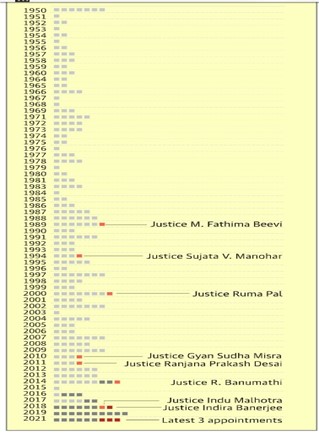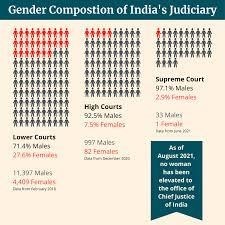Why Judiciary seems Male to us?
Yatin Kumar
Campus law centre, DU
This Blog is written by Yatin Kumar, a First Year Law Student of Campus law centre, DU


The judicial system in a society has existed for a long time since the societal structure was organized. When groups of people live in a community or tribe the clash between them is obvious. Since ancient times the role division between men and women has been that of the bread earner and house maker and being the bread earner, the rules framed in society were predominantly framed by males and the ones who would implement these rules were males.
It was in 1916 when the women who had landholding got voting rights in Britain, succeeding the protest demanding political rights in India were granted first by the kingdom of Madras in 1919 followed by other British colonies.
REPRESENTATION OF WOMEN IN JUDICIARY
Talking about the modern judiciary when the see the oldest modern democracy is the UNITED STATES in 1787 established a federal democratic republic. Historically, the judicial system in the United States has been predominantly male. It wasn't until Arabella Mansfield broke barriers in 1869 by becoming the first female lawyer in the country, a full 80 years after the establishment of the judicial system. Before her achievement, women were often explicitly barred from practicing law due to their gender.
In 1928, Genevieve Rose Cline was the first woman appointed to the federal bench, 59 years after Arabella Mansfield broke barriers as the first female lawyer in the U.S., and nearly a century and a half after the establishment of the country's court system. Today though the number of females number risen to 39.5% of total judges in the US it a far away from the equality that women deserve. Moving to NORWAY in 1814 when the modern judiciary was established there but it too took more than a century and a half to have women holding the position of a judge in 1960
Moving ahead to the world's biggest democracy is INDIA, which established its supreme court in 1935 and became independent in 1947. In 17 states, between 2007 and 2017, 36.45% of judges and magistrates were women, researchers with the Judicial Reforms Initiative at Vidhi Centre for Legal Policy, a think tank, wrote in January 2020 in the Economic and Political Weekly (EPW). In comparison, 11.75% of women joined as district judges through direct recruitment over the same period, according to data from 13 states.
The chart shows the serving women judges (in red), retired women judges (in a lighter shade of red), serving men judges/Chief Justices (in grey), and retired men judges/Chief Justices (in light red) of the SC according to their year of appointment as of August 31. Only 11 of the 256 judges (4.2%) who have served/ are serving at the apex court were/are women. Four out of the 33 judges (12%) currently serving are women.


It was in 1989 after around 40 years of independence 1st woman justice J M. FATHIMA BEEVI became supreme court judge opening the door of the highest judiciary for women. Moving to the federal and lower courts the women judges though have a bit more representation than that of the Supreme Court but not enough to have an equal status.


Reasons for PRE-DOMINANCE of males in the judiciary
• Patriarchal Attitude: The “old boys’ club mentality” makes it harder for women to lobby for judicial posts.
o Also, inadequate support from family results in women frequently dropping out mid-career and it shows the patriarchally prescribed gender roles.
o Not Enough Women In Litigation
Since lawyers elevated from the bar to the bench form a significant proportion of judges in the high courts and Supreme Court, it is worth noting that the number of women advocates is still low, reducing the pool from which women judges can be selected. While data on the number of women in the legal profession as a whole is not available, a 2020 news report estimates that women make up only 15% of all enrolled advocates in the country.
• Household Responsibilities: Women can get into the formal workforce but are often hindered due to the lack of sharing of household chores and the responsibility of bringing up kids.
• Rules and Regulations:
o Continuous Practice: The 7-year criteria of continuous practice for appointment of District Judge under Article 233. o Age Bar: Most States’ Judicial rule of a minimum age of 35 years for entry as a district judge through direct recruitment.
▪ Also, no one below the age of 55 years can be appointed as a judge in the Supreme Court. o Marriage and Family responsibilities in this age group hampers the women’s representation.
• Gender Bias in the Recruitment Process: Appointments to Higher Judiciary is through an opaque Collegium System where the eligibility and selection criteria are not known. As per critics, this system of appointment is based on favourable evaluations and professional/personal networks. o As per a Research Paper ‘Structural and Discretionary Bias: Appointment of Women Judges in India’ 13 Judges out of 19 interviewed acknowledged the gender bias that exists in the appointment procedure of Judges to the Supreme Court and High Courts.
• Missing a Bond: In 2017, senior advocate Indira Jaising said that though the representation of women is increasing they are isolated and not very bonded.
o Male judges have a friendly body when speaking to male lawyers.
• No Support through Reservation in Higher Judiciary: While reservations for women are available in the lower courts of many states, these policies are yet to be implemented in the Higher Judiciary.
• Neglect of Academicians: There is no provision for the appointment of any distinguished jurist, (where women can make their way) to the supreme court.
• Miscellaneous Factors: Sexual harassment, clients not trusting women advocates with high-stake cases, and lack of supportive infrastructure, from toilets to maternity leave.
In 6,000 courts across the country, 22% of them do not have separate toilets for women.
Significance of Having More Women in the Judiciary
• Improve the Quality of Judicial Review and Adjudication: It is because having more women in the judiciary is about: o The matter of the credibility and legitimacy of courts or the language and vocabularies of judgments
o The gender-neutral administration of courts
▪ Having more women on the bench can contribute to a more effective space to deliver justice in India.
▪ Example: Justice Sujata Manohar was responsible for writing up the revolutionary Vishakha Guidelines.
• A Step towards the Empowerment of Indian Women: The Indian judiciary marshalled women’s fights for equality, equal opportunity, dignity, and autonomy, and having more women on the bench, will lead to women’s empowerment and justice.
• Wider Justice and Inclusivity: It can help to reduce the high pendency of cases in the judiciary, and also, higher numbers of female judges can increase the willingness of more women to seek justice. o Adequate women’s representation will meet the needs of women and other underserved communities.
• Availability of Varied Views: A high diversity of judges would bring different and better perspectives and enrich and strengthen the ability of judicial reasoning to encompass and respond to varied social contexts and experiences.
• Increase Gender Sensitivity in the Judgements: There are various instances when women’s protection laws are diluted without considering the issue’s sensitivity. But with more women representation in the judiciary, this problem will also be resolved.
• Action on International Obligations: Sustainable Development Goal 5 of the United Nations calls for attaining gender equality and the greater representation of women in the judiciary would be a desirable step in the achievement of the obligations.
Way Forward to the Gender-Neutral Judiciary
• Sensitization through Inclusivity: There is a need to bring institutional, social, and behavioural change by sensitizing and emphasizing inclusivity. All India Bar Examination should contain questions or sections relating to gender sensitization.
o Former CJI Justice Chandrachud correctly observed that the Feminist approach should be imbibed while dealing with the law.
• Overcoming Patriarchal Mindset: The representation of women in the judiciary needs to be increased, and for this, the change of patriarchal mindset is most important. Unless women are empowered, justice cannot be done for them.
o It should be the realization that women are not subordinate in marriage and should be encouraged to balance work and family life.
• Reservation for Women in Higher Judiciary: For Women, in the appointment of higher judiciary the provision of the reservation should be incorporated without diluting the merit. o Former CJI Justice Ramanna had exhorted women lawyers to strongly raise their demand for 50% reservation in the judiciary.
• Formation of Gender Bias Task Forces: Similar to the Gender Bias
Task Forces in the US, which look at how gender affects court systems, India needs to form such a committee to provide significant suggestions (International Association of Women Judges, 2019).
• A Mentorship System to Counter Challenges: The Geneva Forum on Women in Judiciary (2013) suggested a mentorship system where senior women judges and lawyers can help and guide their younger peers by providing valuable suggestions to counter the challenges they face.
Lower representation of women in the judiciary is ever persisting problem in the judiciary which leads to the pertaining syndrome of patriarchy and crime against women and needs to be addressed with immediate effect.
The entry of women judges into spaces from which they had historically been excluded has been a positive step in the direction of
judiciaries being perceived as being more
transparent, inclusive, and representative of the people whose lives they affect. By their mere
presence, women judges enhance the legitimacy
of courts, sending a powerful signal that they are open and accessible to those who seek recourse to justice.
Judge Vanessa Ruiz, President of the International Association of Women Judges
References :
· https://www.thewomb.in/gender-gap-in-judiciary/
· https://www.investopedia.com/gender-representation-in-the-judiciary-5113183
· https://www.theguardian.com/law/2020/jan/29/white-men-still-dominate-judiciary-says-justice-report
